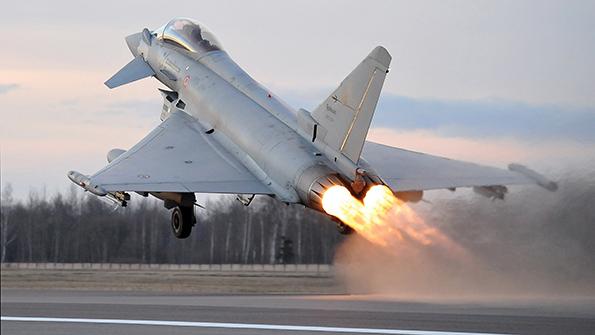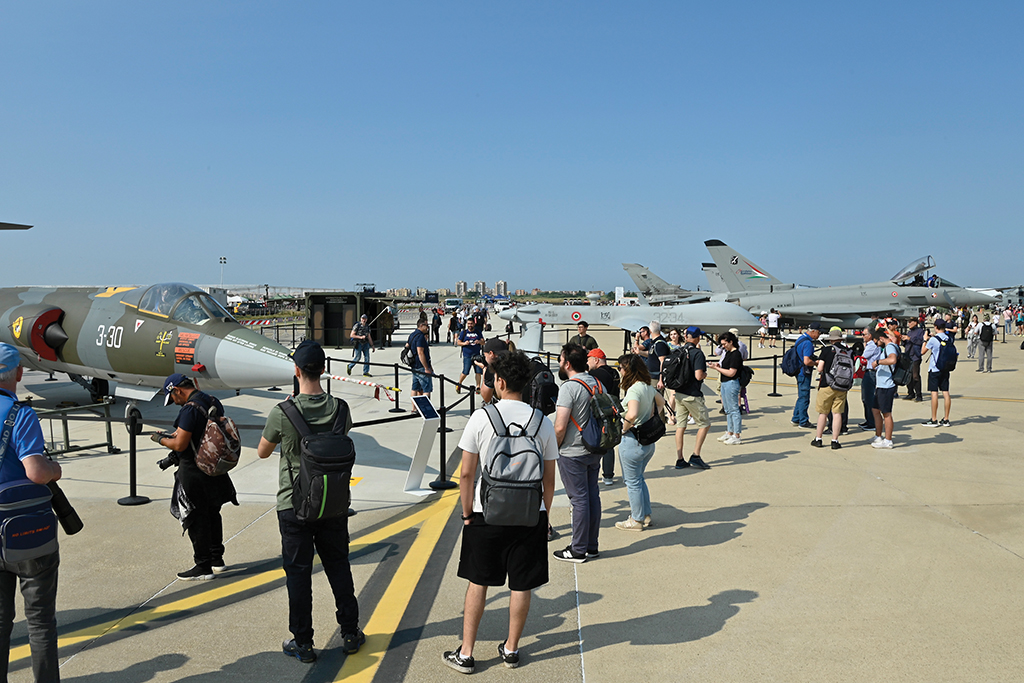
While their primary role has been national air defense, the Italian Air Force’s Eurofighters are beginning to take on additional missions such as ground attack and tactical reconnaissance.
Marking its centenary this year, the Italian Air Force is acknowledging its formidable achievements and considering its future mission in an increasingly uncertain world.
Formed as the Regia Aeronautica in 1923, the service established itself early as specializing in long-range aviation, with pilots flying record-breaking distances. After the post-World War II renewal, the air force supported dozens of international and NATO missions and became one of the first air services in Europe to recognize the importance of space.
- Italy is building a fleet of F-35 and Eurofighter combat aircraft
- Its ISR capability is growing with new Gulfstream G550 platforms
- The air force is looking for maritime patrol capability beyond the P-72
And now the Italian Air Force is preparing to evolve again. It is a staunch backer of the F-35 Joint Strike Fighter, a platform that looks set to play a more important role within the service than it did just two years ago with Italy increasingly recognized as its lead European operator. The air force is also participating in development of the sixth-generation fighter that is planned to emerge from the Global Combat Air Program with Japan and the UK.
But beyond its combat air capability, the Italian Air Force also seeks to grow its space and intelligence, surveillance and reconnaissance (ISR) capacities and continue to be a European pioneer in uncrewed aircraft systems (UAS). It is poised to fly three researchers and experiments on Virgin Galactic’s first commercial suborbital flight.
The service needs to prepare for a different operational environment from its European and NATO counterparts as well. While it recognizes and shares many of the same threats as its neighbors, Italy also keeps a watchful eye on Europe’s soft underbelly: the Mediterranean Sea, North Africa and into the Middle East.
“The Mediterranean region is a strategic area of interest for Italy,” Brig. Gen. Luciano Ippoliti, chief of the Italian Air Force’s Aerospace Plans and Policy Department told Aviation Week at the service’s AeroSpace Power Conference in Rome in mid-May. “Whatever happens in this region is something that can affect our future, liberty, freedom and the stability of Europe.”
It was just 12 years ago that NATO jets from across the alliance converged on Italy to conduct operations over Libya during the Arab Spring. Italy and other European countries have continued to monitor the subsequent civil war and unstable cease-fire.
The need to survey activities in North Africa and along the Mediterranean has prompted a reassessment of the air force’s requirements and driven significant investments in its ISR capability.
The service received a pair of Gulfstream G550 business-jet-based conformal airborne early warning (CAEW) aircraft from Israel—along with an observation satellite—in exchange for Israel acquiring 30 M-346 jet trainers from Leonardo. Italy has since decided to purchase eight more G550s for a range of ISR and electronic warfare missions.

The final decision on how the G550s will be configured is pending, but two of the eight are planned to be used as CAEW platforms, for a fleet of four. An undisclosed number are set to be in the Joint Airborne Multisensor Multimission System (JAMMS) configuration for command-and-control and intelligence-gathering missions, and the remainder are to be in a Multisensor Multimission System configuration for standoff jamming.
“This is a very diverse program, so by choosing a single platform, the logistic requirements are lower, the training burden is lower and then you just missionize the platform,” Brig. Gen. Igor Bruni, head of the Italian Air Staff’s Logistics Department, said at the AeroSpace Power Conference.
“ISR and electronic warfare are gaps we are trying to fill,” Ippoliti said. “We also feel we need to increase our airborne early warning, because we believe this capability needs to be increased by all nations.” He noted that Italy’s CAEW will be able to contribute to NATO’s Alliance Future Surveillance and Control capability, due to enter service in 2035.
The ISR role of the air force’s Leonardo C-27J Spartan airlifters is slated to grow as well with additional roll-on, roll-off payloads beyond the Jamming and Electronic Defense Instrumentation (JEDI) capability already fielded, Bruni said.
The service plans to take delivery of the Praetorian payload for special forces support, too. Another ISR capability Italy hopes to reestablish is maritime patrol and anti-submarine warfare, which was lost with the retirement of the Breguet Atlantic in 2017.
The P-72 derivative of the ATR 72 regional airliner currently performs maritime patrol, but this is an “interim solution,” Ippoliti said. “The P-72 was the only solution we had at that time because budgets were limited. It is doing an excellent job, but we have lost the capability to intervene under the sea.”
Italy seeks to refresh its anti--submarine warfare capability with a platform that can reach anywhere in the Mediterranean region. The country will need more aircraft than just the P-72s, Ippoliti added.
Rome aims to introduce the new maritime patroller toward the end of the decade but has not decided whether it will be a product of national industry, such as an upgraded P-72, or an international option. At the AeroSpace Power Conference, Boeing proposed its P-8 Poseidon maritime patroller, while Leonardo has offered a maritime patrol variant of the C-27J.
Meanwhile, the air force is consolidating its combat aircraft fleets. Just a handful of AMX International A-11 Ghibli light combat aircraft developed with Brazil’s Embraer remain in service, and they are due to be phased out this year. The Panavia Tornado’s roles are being taken over by both the F-35 and Eurofighter Typhoon, which together are planned to form the backbone of the country’s fighter force in the coming years.
Italy has been Europe’s lead nation on the F-35. Along with building the aircraft in-country, it was among the first European nations to declare an initial operational capability as well as the first to take the aircraft across the Atlantic and deploy it to Iceland for NATO’s air policing mission there.
It may also become the first European nation to build up to its original program of record—131 aircraft. The current plan is to acquire 90 F-35s, including 60 F-35As and 15 F-35Bs for the air force and 15 F-35Bs for the navy. But this spring, Air Force Chief Gen. Luca Goretti called on lawmakers to back a plan to restore Italy’s order to 131 aircraft and potentially speed up their purchase.
“That discussion is now on the table,” Bruni said. “We are very happy with the [F-35] program. [And] the feedback about the way we are operating the machines—from the enterprise and from across Europe—makes us humble, as our personnel are recognized as among the best operators.”
Operating alongside the F-35 into the 2030s will be Italy’s Eurofighters, a type primarily used for air defense but growing its swing-role capability with ground-attack missions and reconnaissance tasks with the Rafael RecceLite pod.

“[The] Eurofighter is now fully established on a dense progressive technical improvement program,” Ippoliti said. “But the improvement of the radar with the new electronically scanned array is the main effort we need to take care of right now.”
Italy is monitoring progress with the UK-led development of the European Common Radar System Mk. 2, and the Italian defense electronics arm of Leonardo is supporting those efforts.
Although the Global Combat fighter is planned to replace the Typhoon, the Italian Air Force expects to have a mixed fleet of fourth-, fifth- and sixth-generation combat aircraft in its inventory for several years during the transition. To support that evolution, the service is exploring life extension options for some of the Typhoons, notably the Tranche 3 aircraft. The earlier Tranche 1 models, largely used for training, will be phased out in the coming years, Bruni said.
Italy also hopes to hang on to its role as a pioneer of remotely piloted or uncrewed aircraft systems. It was the first European air force to fly the General Atomics MQ-1 Predator and an early customer for the MQ-9 Reaper. The MQ-1 was phased out late last year, and the country is preparing to introduce the MQ-9 Block 5 aircraft, pending approvals from lawmakers. It would provide, for the first time, what officials call a kinetic military capability for its UAS.
Italian industry is involved in the development of the four-nation Eurodrone platform planned for delivery in the 2030s as well.
Along with its organic UAS capabilities, the air force supports the operation of NATO’s Alliance Ground Surveillance Northrop Grumman RQ-4D Global Hawks, which have their main operating base in Sigonella, Sicily (AW&ST Jan. 13-26, 2020, p. 50).
Italy has been making its mark in flight training, too. In May, Goretti inaugurated the International Flight Training School at Decimomannu air base in Sardinia. The joint initiative between the Italian Air Force, Leonardo and training firm CAE flies 22 Leonardo T-346 advanced jet trainers and has students from Austria, Canada, Germany, Japan, Qatar, Saudi Arabia and Singapore. The UK Royal Air Force recently signed up as a client due to ongoing issues with its own fighter training. The school is one of the campuses in NATO’s Flight Training Europe initiative to develop a linked network of training facilities across the continent.
“It’s a brand-new idea of doing training; the maintenance of the aircraft will be done by our industry, and our instructors are military and civilian,” Bruni said. “It’s a great showcase for our industry for the T-346 and for the Italian Air Force’s international partnerships.” But he added that with so many customers it is impossible to meet all the requests being received.
Beyond the air fleets, major investments are underway to rebuild the air force’s infrastructure. The Aeroporti Azzurri—Italian for “blue airports”—project aims to make the service’s facilities more sustainable and link them for a new age of information warfare.
“This is a huge effort; we are working from the top to the bottom of Italy,” Bruni said. “Every airfield is different. Structures have different ways of aging depending on where they are, so this has to be done step by step.”
Recognizing that the air force’s air platforms will be increasingly data-hungry, the facilities are planned to be capable of sharing and protecting data, whether it comes in megabytes, gigabytes or terabytes.
“We are taking everything that we have and trying to make it more efficient and better, and we are also considering the green economy,” Bruni said. Other sustainability efforts include studies on how the air force consumes electricity and how it can produce its own energy through re-new--ables such as solar power.
As the Italian Air Force readies itself for a new era of airpower and near-peer warfare, commanders say they have taken the right modernization steps.
“There is no air dominance or air superiority in Ukraine due to [anti--access/area denial], so being able to penetrate these defense capabilities is something that we were right to develop,” Ippoliti said. “Combine this with our increasing ISR and [electronic warfare] capabilities, then the Ukraine situation is confirming our theory that to achieve full control of the battle, you must have control of the airspace.”





